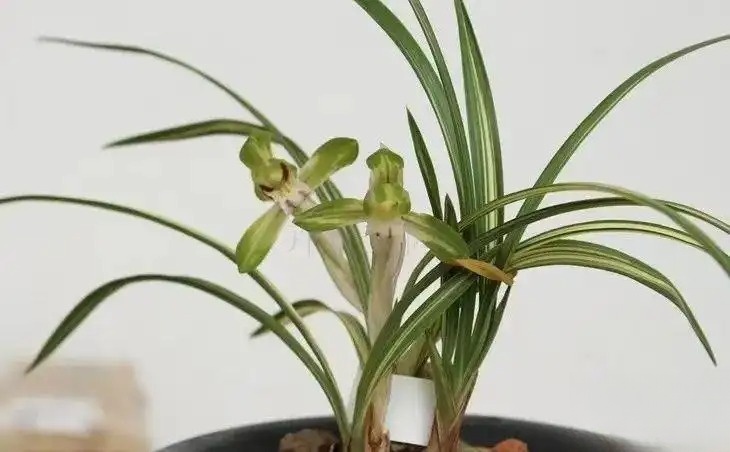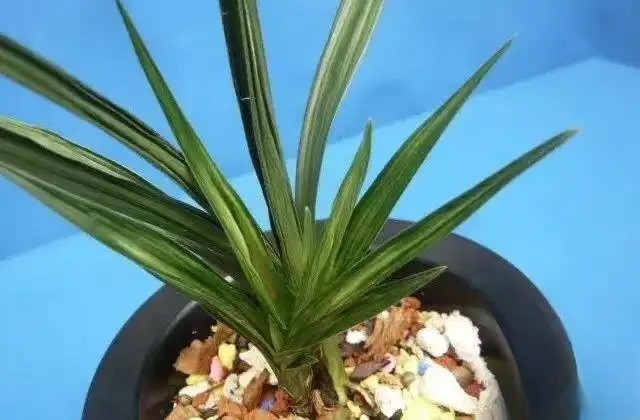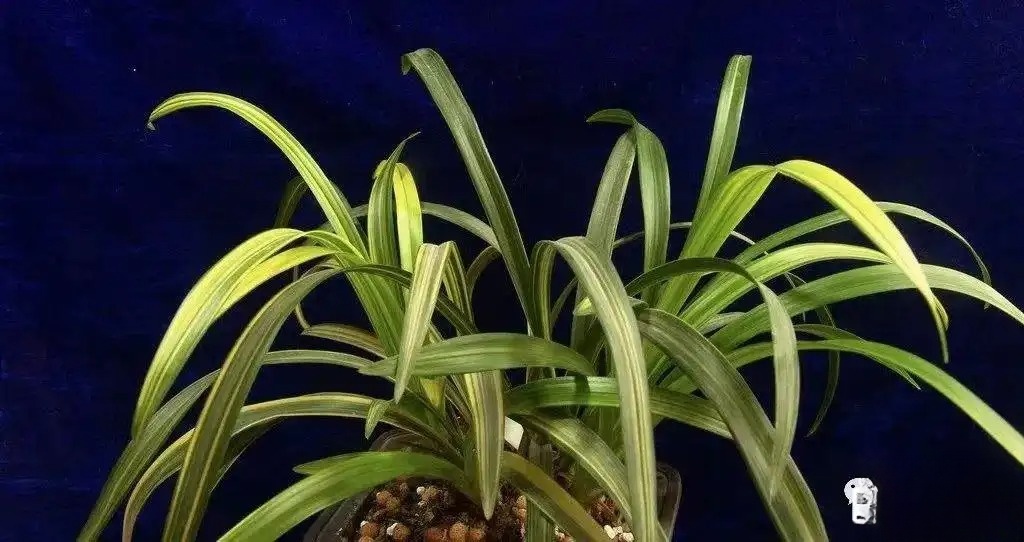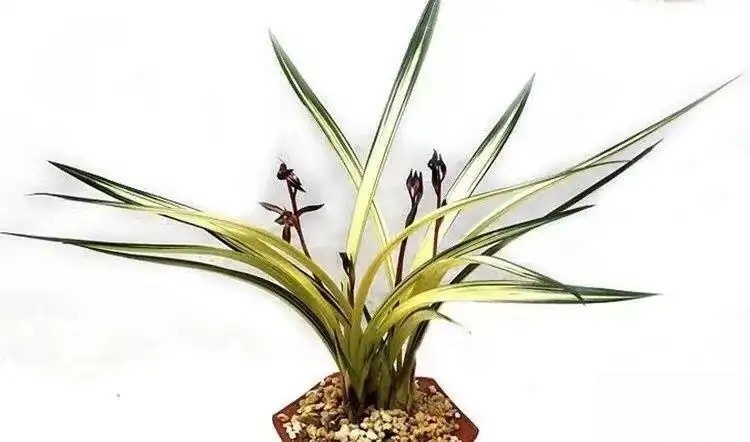Appreciation of orchid "leaf art" and "plant art" (I)
1. Overview of “Leaf Art” and “Plant Art”
There are many kinds of orchids. There are many varieties of orchids in the garden. Whether you want to enjoy the flowers, leaves or plants, there are some extraordinary and famous ones. The number of famous ones is beyond the reach of other flowers. It is well known that orchids are the best among all flowers for their distant and mellow fragrance. The leaves and plant shape of orchids are not just the green leaves, elegant leaves, strong and beautiful plant shape in the general sense, but also have their own unique appreciation content. This is the leaf art and plant art of orchids. Leaf art refers to the decorative and artistic color lines, spots, mosses, and blocks on the leaves, which are white, yellow, mossy or crystal-like, and thus make the orchid leaves look like silk batik, stars, leopard spots, tiger stripes, or embroidered silk brocade, which are ever-changing and charming. These leaf arts are called "handles" by the Japanese, which means things to appreciate on the leaves. Plant art is essentially another form of leaf art. Because orchids are herbaceous, leaf-growing plants without trunks and branches, their plant shape is mainly composed of their leaves. Their special performances include short-leaf dwarf plants, medium-leaf dwarf plants (often composed of wide, short, thick, spoon-shaped, crucian carp-shaped, round-tailed, blunt-tailed leaves), and dragon-shaped plants (often composed of dragon-shaped leaves, wrinkled, thickened, twisted, and strong leaves). This type of orchid often gives people a sense of agility, ingenuity, uprightness, and thriving beauty, and is often loved by viewers. From the above, it can be seen that orchids are not only an important type of flower-viewing plants among many flowers, but also a leader among foliage plants. If all foliage plants are compared, orchids, as foliage plants, have a rich and colorful performance, and it is not wrong to call them the crown of foliage plants.
 Chunlan Daxueling: White with a translucent art, bright art color
Chunlan Daxueling: White with a translucent art, bright art color
The appreciation of orchid leaves by Chinese people has a development process, and the knowledge has been gradually accumulated. At first, the appreciation of orchid leaves was mainly for the beauty of its lines, which is the same as the aesthetic appreciation of Chinese painting and calligraphy. The soft and firm parabolic green leaves of orchids do have a kind of unrestrained beauty and rhythmic beauty. There are few records about the color lines and spots on the leaves in ancient orchid books. Occasionally, they are mentioned as a kind of variety identification, and rarely described as an appreciation point. The appreciation of the color lines and spots on orchid leaves began in Japan.
As early as more than 200 years ago, the craze for orchids with thread art appeared in Japan. At that time, the first orchid variety in Japan was cultivated by a blacksmith and named Kajiya (meaning the blacksmith's house), which was a kind of Jianlan. In 1904, Mr. Toyoyoshi Ohkouchi, a Japanese, found a black orchid with dark green claws and white spots in the bamboo forest in front of Sanyi Station (now Sanyi Station) where he worked in Taiwan. At that time, the orchid community unanimously believed that its leaf art was more beautiful than the previous Jianlan Kajiya in Japan. So it was sold in Taipei for 300 yuan (equivalent to the three or four years' salary of the seller Mr. Toyoyoshi Ohkouchi). This orchid was introduced to Japan and named "Manzuru". Since then, the craze for orchids with thread art has emerged in Taiwan. Half a century later, that is, in the 1950s and 1960s, there were more than 100 kinds of leaf art orchids in Taiwan, and its famous products such as leaf art Daruma often sold for tens of thousands or even hundreds of thousands of yuan per plant. By the 1980s and 1990s, the appreciation of Ye Yilan had spread to Taiwan, Hong Kong, Macau, and even inland China and foreign countries such as Japan and South Korea.
With the massive development of orchid resources in mainland China, there are more and more varieties of orchid leaf art, including not only various leaf art of various orchids, but also crystal art, amber art, etc. The appreciation items are endless. So far, leaf art and plant art have become a major appreciation point of Chinese orchids, and Chinese orchids have become a more ornamental and attractive flower.
 Spring Sword Crystal Dragon: Crystals are arranged vertically on the leaves, forming dragon leaves
Spring Sword Crystal Dragon: Crystals are arranged vertically on the leaves, forming dragon leaves
As for why orchid leaves can form various ornamental leaf designs and why ordinary orchid leaves have so many variations, there are several theories:
(1) Biological mutation: For example, virus invasion can induce mutations in orchid leaves.
(2) Physical mutagenesis: If there are radioactive substances in the growing area, the orchid plants will be exposed to radiation for a long time, which will induce mutations in the orchid leaves.
(3) Chemical mutagenesis: Certain minerals and chemicals in the soil, fertilizers, and drugs may induce mutations in orchid leaves.
(4) Climate and environmental mutation. Orchid leaves mutate because they grow in specific geographical environments, such as hot spring areas and certain islands.
(5) Nutritional imbalance. If a certain nutrient element accumulates excessively in the orchid leaves, or if a certain nutrient element is lacking in the orchid leaves, or if the amount of a certain nutrient element accumulated is insufficient, the color of the orchid leaves may change. For example, it is known that the leaves of plants will turn yellow if they lack magnesium. There is a high possibility that orchid leaves will have mottled art due to an imbalance of elements.
The above theories have been reported, but there has been no strict scientific research report on why orchid leaves have leaf art. The above theories are mostly just some deduced conjectures or individual examples, and lack scientific experiments that can be repeated many times under specific conditions set by humans to support them. Therefore, this issue needs further research by botanists. For other plants, such as some tulips, there are reports of scientific experiments on why leaf art and flower art appear.
In the process of selecting leaf art orchids, how to judge whether a leaf art orchid has a future in cultivation involves the concept of "silver". Generally, there is a thin layer of wax on the surface of orchid leaves, which has a waxy luster. However, on the surface of orchids that are or have the potential to be artistic, there is often a layer of silvery white mist or fine particles, which orchid lovers call "silver". The performance of the "silver" on the back of the leaves is often what orchid lovers must carefully observe when selecting leaf art orchids. At the beginning, Molan Yinhua only had some invisible silk art, but because the "silver" on the back of the leaves was thick and dense, it was favored. After cultivation, it developed into a high-grade leaf art product with multiple bundles of fine silver threads. Generally speaking, among the orchids from the mountains, there are one or two obvious silk threads and the back of the leaves has a strong "silver", which can develop into a very good leaf art orchid. If the silk thread is from the base of the leaf, this possibility is greater. However, if there are only a few bright or dim white lines on the leaf surface and the "silver" on the front and back of the leaf is dark and too thick, it is difficult to produce beautiful leaf art, and even the original small amount of white lines will be covered by the dark "silver" and the art will be bad. In short, in the selection and cultivation of leaf art orchids, it is necessary to pay attention to whether the "silver" on the back of the leaf is thick and whether the "silver light" is visible.
 Jianlan Guanyin Brocade: Jianlan's famous Guanyin is plain and transparent, with elegant color and simple color
Jianlan Guanyin Brocade: Jianlan's famous Guanyin is plain and transparent, with elegant color and simple color
Another concept is "ghost buds". Orchid lovers usually call single white or light yellow orchid buds "ghost buds", which means that this type of buds only have the shadow of buds and leaves, without the usual green color of buds and leaves, like lifeless ghosts. If this type of buds has no green claws, caps, lines, or dots on the whole bud, no green at the base, and no light green shadow on the leaf surface, it is a "pure ghost bud". Because the whole bud has no chlorophyll, no nutrition is produced, it is difficult to survive, and it is an invalid bud, and it will soon die. If there are only a few green lines and green dots. The buds are also difficult to grow well, and will gradually dry and rot from the tip of the bud down, that is, the bud tail will rot, and soon the whole bud will rot and dry. Only those white or yellow buds with green claws, green caps, green covers, green stripes, or green spots have the possibility of growing into beautiful leaf art. Such white or yellow buds can grow into medium transparent art, powder spot art, medium spot stripe art, tiger spot art, etc., and the art direction is usually better. Therefore, the bright-petaled "ghost buds" are also the knowledge required for the selection, breeding and cultivation of leaf art orchids.
The cultivation and management of leaf art orchids and plant art orchids are similar to those of general fine orchids. There are a few points to note:
(1) It is best to collect the soil from the native habitat of the orchids you collected. The soil you bring back can be used to plant the orchids you collected, or saved for repotting or planting other orchids.
(2) Planting materials should be slightly acidic and low in nitrogen, such as stone, pottery, weathered gravel, etc. Pond mud , so as to avoid the nitrogen fertilizer being sufficient to facilitate the greening of leaves and cover the leaves.
(3) When the leaves are not stable, a small amount of potassium fertilizer and phosphorus fertilizer can be used. After the leaves are stable, phosphorus, nitrogen and potassium compound fertilizer can be used to strengthen the leaves.
(4) Dwarf orchids and orchids with dragon-shaped leaves should be given enough fertilizer to make their leaves thicker and their dragon-shaped leaves more prominent.
(5) The temperature difference between day and night should be large, and it may be a bit cold at night.
( 6) When new buds first emerge, they should be placed in a place with weak light and good ventilation. The orchid pot should be well ventilated and the air humidity should be high. After the buds grow, follow the general management methods.
(7) You can try adding some minerals or rare earths containing germanium, cobalt, manganese, boron, niobium, rubidium, tantalum, sulfur, iron, etc., and observe the changes in the leaf art to see if it can make the art better.
(8) If some orchids have artistic features and some do not, they can be planted separately to develop the artistic parts.
 Molan Ruihuang: Transparent Art, Beautiful as Crown Art
Molan Ruihuang: Transparent Art, Beautiful as Crown Art
These are all based on experience and are for reference only.
The appreciation points of leaf art and plant art of various orchids have become increasingly rich. The classification of various leaf arts can only be a rough idea, and the various concepts of the classification can only be vague concepts in formal logic. That is, there are often intersections and overlaps between various leaf arts. It can be predicted that with the large-scale development of orchid resources in various places and the continuous discovery of new varieties, the appreciation points of leaf art will continue to develop, that is, there will be new leaf art appreciation points, and we look forward to it.
To be continued!!!